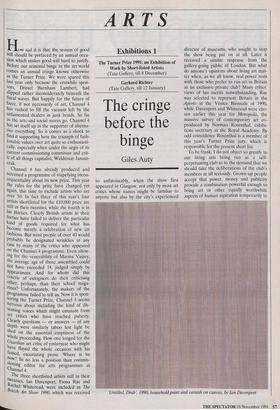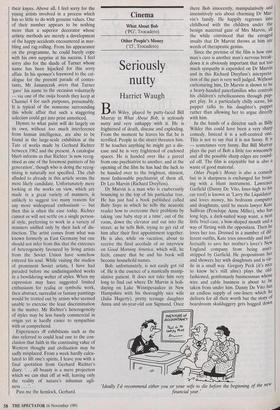ARTS
ow sad it is that the season of good
H
Will should be prefaced by an annual occa- sion which makes good will hard to justify. Before our seasonal binge in the art world comes an annual cringe known otherwise as the Turner Prize. We were spared this last year only because the erstwhile spon- sors, Drexel Burnham Lambert, had Slipped rather inconsiderately beneath the fiscal waves. But happily for the future of farce, if not necessarily of art, Channel 4 has rushed to fill the vacuum left by the unlamented dealers in junk bonds. So far as the arts and social mores go, Channel 4 has set itself up as the supporter of alterna- tive everything. So it comes as a shock to find it supporting here the triumph of fash- ionable values over art quite so enthusiasti- cally, especially when under the aegis of its current commissioning commissar and crit- ic of all things capitalist, Waldemar Janusz- czak.
Channel 4 has already produced and screened a programme of stupefying incon- sequentiality about its new prize. This year the rules for the prize have changed yet again, this time to exclude artists who are over 50. In fact three of this year's four artists shortlisted for the £.10,000 prize are snll in their twenties, while the fourth is in his thirties. Clearly British artists in their forties have failed to deliver the particular kind of goods required for what has become merely a celebration of new art fashions. But most people of over 40 would Probably be designated wrinklies in any case by many of the critics who appeared on the Channel 4 programme. Even allow- ing for the venerability of Marina Vaizey, the average age of those assembled could not have exceeded 14, judged simply by aPPearances. And for whom did this coterie of eulogisers do their criticising Other, perhaps, than their school maga- zines? Unfortunately, the makers of the Programme failed to tell us. Now it is spon- soring the Turner Prize, Channel 4 seems nervous about including the kind of dis- senting voices which might emanate from art critics who have reached puberty. Clearly questions — or answers — of any depth were similarly taboo lest light be shed on the essential emptiness of the whole proceeding. How one longed for the Guardian art critic of yesteryear who might gave flayed the whole occasion with his amed, excoriating prose. Where is he n.ovv? In no less a position than commis- sioning editor for arts programmes at Channel 4.
The three shortlisted artists still in their tIventies, Ian Davenport, Fiona Rae and Rachel Whiteread, were included in The British Art Show 1990, which was received
Exhibitions 1
The Turner Prize 1991: an Exhibition of Work by Short-listed Artists (Tate Gallery, till 8 December) Gerhard Richter (Tate Gallery, till 12 January)
The cringe before the binge
Giles Auty
so unfavourably, when the show first appeared in Glasgow, not only by most art critics whose names might be familiar to anyone but also by the city's experienced
director of museums, who sought to stop the show being put on at all. Later it received a similar response from the gallery-going public of London. But what do anyone's opinions about living art mat- ter when, as we all know, real power rests with those who prefer to run art in Britain as an exclusive private club? Many critics' views of her merits notwithstanding, Rae was selected to represent Britain in the Aperto at the Venice Biennale of 1990, while Davenport and Whiteread were cho- sen earlier this year for Metropolis, the massive survey of contemporary art co- produced by Norman Rosenthal, exhibi- tions secretary at the Royal Academy. By odd coincidence Rosenthal is a member of this year's Turner Prize jury, which is responsible for thepresent short list.
To be frank, I do not object so greatly to our living arts being run as a self- perpetuating club as to the demand that we should take the deliberations of the club's members at all seriously. Grown-up people accept that power, money and publicity provide a combination powerful enough to bring art or other equally worthwhile aspects of human aspiration temporarily to 'Untitled, Drab', 1990, household paint and varnish on canvas, by Ian Davenport their knees. Above all, I feel sorry for the young artists involved in a process which has so little to do with genuine values. One of their number appears to be nothing more than a superior decorator whose artistic Methods are merely a development of the happy accidents encountered in mar- bling and rag-rolling. From his appearance on the programme, he could barely cope with his own surprise at his success. I feel sorry also for the shade of Turner whose name has been hijacked for this sorry affair. In his sponsor's foreword to the cat- alogue for the present parade of contes- tants, Mr Januszczak avers that Turner 'gave' his name to the occasion voluntarily — via one of the ouija boards they keep at Channel 4 for such purposes, presumably. It is typical of the nonsense surrounding this whole affair that such a staggering solecism could get into print unnoticed.
Hymns to what paint will do largely on its own, without too much interference from human intelligence, are also to be found in the large-scale exhibition at the Tate of works made by Gerhard Richter between 1962 and the present. A catalogue blurb informs us that Richter 'is now recog- nised as one of the foremost painters of his generation', though who is doing the recog- nising is naturally not specified. The club alluded to already in this article seems the most likely candidate. Unfortunately mere looking at the works on view, which are made in a great variety of manners, is unlikely to suggest too many reasons for any more widespread enthusiasm — but then this is often the case today. Richter cannot or will not settle on a single person- al style, preferring to work in a variety of manners unified only by their lack of dis- tinction. The artist comes from what was known formerly as East Germany but one should not infer from this that the extremes of heterogeneity favoured by living artists from the Soviet Union have somehow entered his soul. While visiting the studios of prominent Soviet artists, I have had paraded before me undistinguished works in a bewildering welter of styles. When my expression may have suggested limited enthusiasm for realist or symbolic work, then abstract, surrealist or fantasy paintings would be trotted out by artists who seemed unable to exercise the least discrimination in the matter. Mr Richter's heterogeneity of styles may be less basely commercial in origin yet is hardly easier to sympathise with or comprehend.
Experiences df exhibitions such as the duo referred to could lead one to the con- clusion that faith in the continuing value of Western thought and civilisation may be sadly misplaced. From a week hardly calcu- lated to lift one's spirits, I leave you with a final quotation from Gerhard Richter's diary: `... all beauty is a mere projection which we can shut off at will, leaving only the reality of nature's inhuman ugli- ness . .
Pass me the hemlock, Gerhard.











































































 Previous page
Previous page